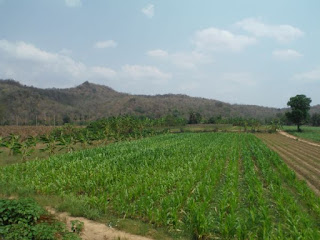We learned that we really knew very little about this critical activity
carried out by the Japanese during World War II. After visiting the museum and
surveying the POW cemetery, we actually boarded a train and traveled from Kanchanaburi to the Tham Kra Sae Bridge at Sai Yok Station.
Our train crosses the bridge spanning the river and then headed
inland. The Sai Yok
Station and the Tham Kra Sae Bridge is along the Kwae Noi ( tributary). In Kanchanaburi you can walk across the famous "Bridge on the River Kwai." (More on the name later). From here you can see a now empty piece of land where one of the POW camps was located. There are side patios so you can hop off the tracks if/when a train comes along. There's even a sign with instructions for moving off the tracks.
Yes, folks, that light is on the train and a train is coming. What does everyone do? People stand there taking pictures as the train comes right at them as it crosses the bridge.
The arched spans are original. The more rectangular spans had to be replaced after the Allied Forces destroyed part of the middle of the bridge.
Views from the bridge and surrounding area.
On the train, our guide explained that people still travel over these mountains to illegally enter
Thailand. The crossing is extremely difficult.
B noticed this while on the train.
We passed fields of cassava, sugar cane and others.
Perhaps original pilings now wasting away.
We begin to get close to Sai Yok Station.
Views from the bridge and surrounding area.
B noticed this while on the train.
We passed fields of cassava, sugar cane and others.
Perhaps original pilings now wasting away.
We begin to get close to Sai Yok Station.
We each
received a certificate for our train ride. On the train they served us a boxed
snack complete with water.
That was included in the fee for the train ride. If
you were still hungry, frequently someone came through the car selling additional
food items.
The special tourist car we were in cost 300 Baht per person (about 9 USD). The non-tourist cars are only 100 Baht. One of our fellow passengers from the tourist
car pointed out that the car for local folks had pads on the seats. Ours did
not. We did get the free snack and water, however. No cars had air conditioning.
Speaking of water, every time we turned around, our tour guide Wantana
was handing us another bottle of water. It was hot, even hotter than at home. We knew it would be even warmer in
Bangkok so we brought our Camelbak backpack to carry our own
water. Nonetheless, water bottles were offered at every turn. Several times over the course of the 2 days we spent with Wantana, she
also stopped and purchased pre-chilled towels for us to use to wipe off the sweat. After the first one, we started noticing other refrigerated units
holding more of these individually sealed and already chilled small towels. Nice!
Sai Yok Station was
about 65 km from Kanchanaburi. This is located at the north end of the Wang Pho
viaduct. The Tham Kra Sae Bridge is the
longest railway bridge in Thailand. At this location we also visited an above ground
cave – the Kra Sae Cave. Our guide told us that the cave was used as a hospital
for the POW camp that was located here. It might also have been used for storage
of goods by the Japanese or as a camp site for Japanese soldiers. Stories
abound! There is a legend that Japanese gold was buried in the cave and you can
see signs of all the digging and attempted looting that’s gone on here. Today
there is a Buddha. We didn't get any good photos
I was surprised that the Pad
Thai was very mild considering I was eating it in Thailand. I even had to add Thai chili sauce. After lunch I tried the local coconut ice cream. It was
frozen, but wasn’t very coconutty to my taste buds. Cost? 20 Baht (60 cents
US).
















No comments:
Post a Comment
Feel free to comment or ask questions...